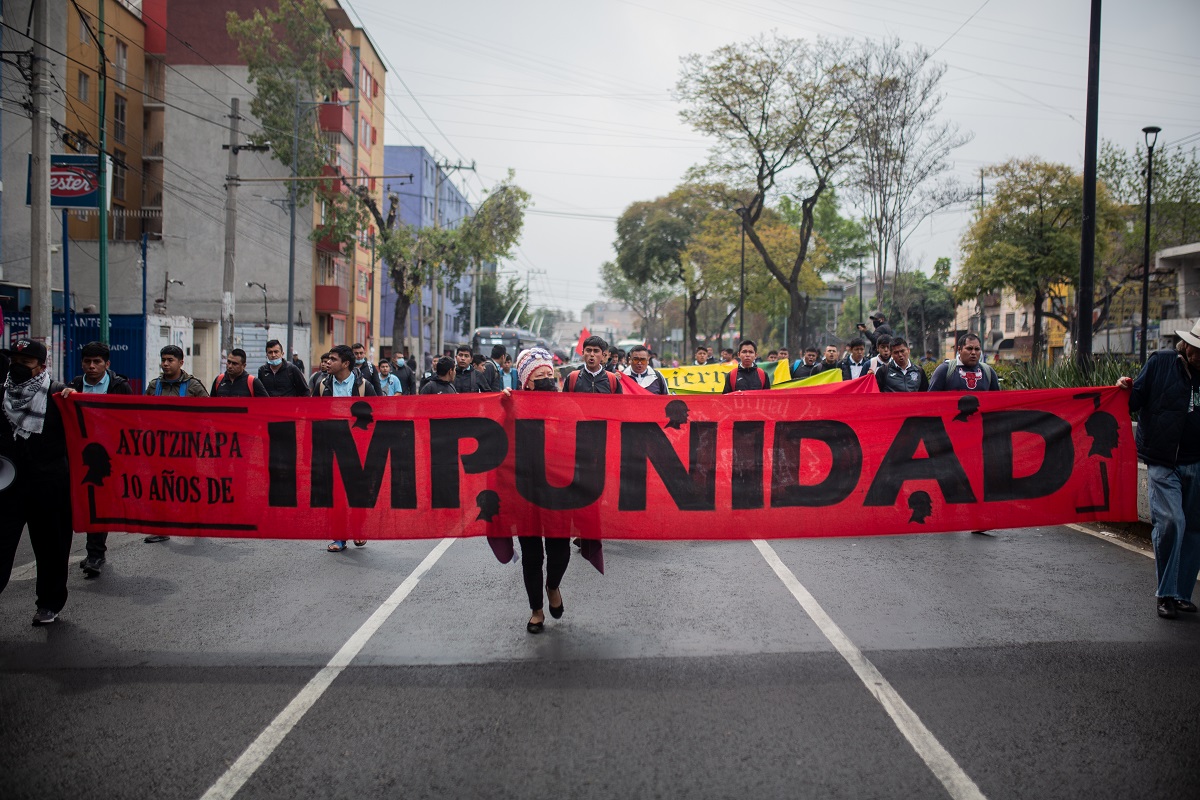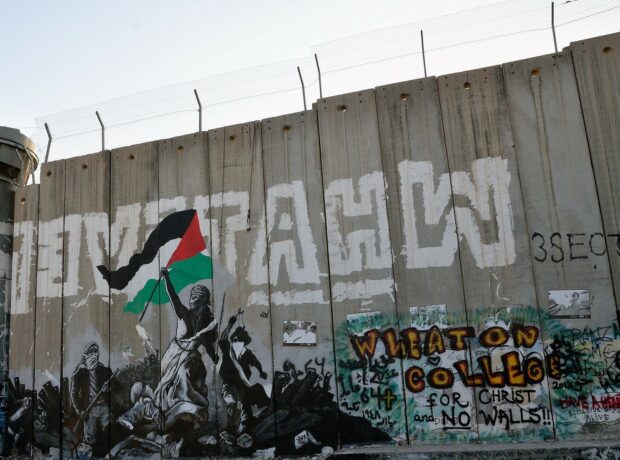Ten years have passed since 43 students from Ayotzinapa, Mexico – Los 43 – were detained and disappeared in one of the country’s most infamous human rights cases. Their parents, united in pain, have spent the decade searching for their children and challenging misinformation and indifference from those in power. On the tenth anniversary, as Mexico’s first female president is about to take office, Paula González Gavilanes revisits the case while parents continue their protest.
“Benjamín was very close to me and his two sisters,” says Cristina Bautista, a mother from the indigenous Alpuyecancingo community in Guerrero, south-west Mexico. Cristina has spent 10 years missing her son and now treasures her memories of their time together.
“He was always helping in the kitchen, washing dishes and sweeping. We are campesinos [“peasant” smallholders or tenant farmers], so we work together in the corn field. We also made bread for a living, which he would sell early in the morning with his sister, to help us and help support his studies. I always have him in mind,” she adds, “I miss him. I need to know where Benjamín is.”
On September 26, 2014, Benjamín was one of 43 students who left their rural college to travel to a memorial in Mexico City seven hours away. The trainee teachers from Ayotzinapa were planning to join thousands of other students from across the country on October 2 at an annual gathering in the capital city commemorating the massacre of 350 protesters (mainly students) there in 1968.
In Iguala, halfway there, they boarded several buses to continue their journey to the capital. But on leaving the station, the buses were chased and the students were attacked by local police who, it was later alleged, were colluding with a drug cartel. Three students and three civilians were killed. Some students managed to escape. And 43 others were detained and disappeared, now known as Los 43. Cristina’s son, Benjamín Asencio Bautista, aged 19, was among them.
The 43 students attended the Raul Isidro Burgos rural school in an under-privileged region of Mexico where criminal organizations have a heavy presence. Its students, mostly from working-class and low-income families, train to become teachers. Notable alumni include Lucio Cabañas and Genaro Vázques, who in the 1960s and ‘70s led peasants’ rights movements in Guerrero. The Isidro Burgos school remains defiant, and its historic opposition to the government has made it a target of state surveillance.
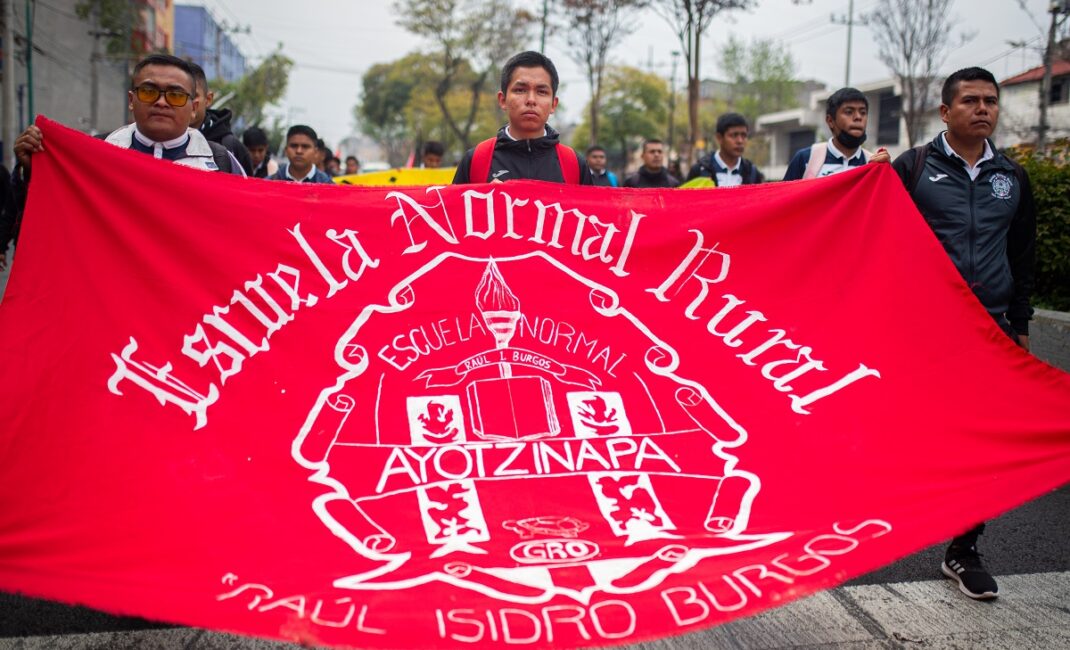
Students from Isidro Burgos school hold a large red banner at the Mexico City protest – by Paula González Gavilanes
For a decade now, Cristina and the parents of the other missing students have been searching for their children and for the truth behind their disappearance. United in sorrow, they have challenged those in power. Some have since died, but the rest continue the pursuit of truth and justice.
It changed our lives,” says Cristina. “It’s easy to say ‘10 years’, but fighting these 10 years has been really hard.”
Like the parents of Los 43, there are thousands more families across Mexico looking for their loved ones. In 2006, Mexico’s so-called “War on drugs” was declared, sparking an internal armed conflict. Since then, more than 400,000 people have been killed, and over 100,000 have gone missing. Happening within this context, the Ayotzinapa enforced disappearances exposed the complex relationship between the Mexican state and organized crime.
Besides demanding truth, Cristina and the other families want justice. Damning reports have found that authorities from various levels of government were involved in the disappearance and the cover-up that followed. And Ayotzinapa exemplifies a broader issue of impunity in Mexico, where, staggeringly, more than 99% of enforced disappearances go unpunished and unsolved. This crisis of violence demands a different approach. Could transitional justice provide an answer?
Transitional justice: An opportunity for Mexico?
Transitional justice has been applied in societies going through a significant change after periods of armed conflict, dictatorship or human rights abuses, such as in South Africa after Apartheid or more recently in Colombia after the 2016 Peace Agreement between the government, guerillas and paramilitary groups. The aims of transitional justice can include reconciling society, recognising victims and their experience, and contributing to lasting peace, often through four main components: truth; justice; reparation; and guarantees of non-repetition.
For the families of the disappeared, truth is the most important of all. Cristina says: “The truth we seek is to know what really happened on September 26 in Iguala, why our children were taken and where they left them.”
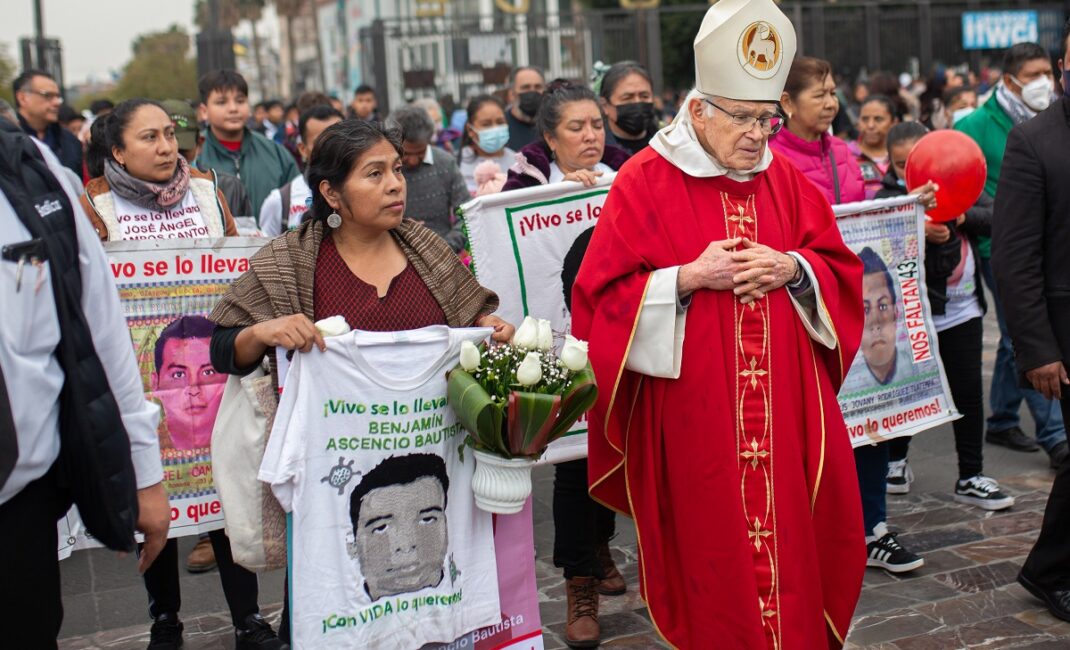
Cristina Bautista, left, with former bishop and human rights defender Raúl Vera, right, holds an image of her missing son Benjamín – by Paula González Gavilanes
The disappearance occurred during the presidency of Enrique Peña Nieto (who was in office from December 2012 to November 2018), when Jesús Murillo Karam was Attorney General of the Prosecutor’s Office. Despite an investigation tarnished with allegations of torture and collusion with the perpetrators, the state titled the findings they presented to the public the “historic truth”.
Instead of solving the case,” says Cristina, “they covered it up. They built the ‘historic truth’ by torturing people, and because our children are children of peasants, they thought it would be easy to deceive us.”
The so-called “historic truth” offered to the parents by Peña Nieto’s administration increased public outrage, and got civil society groups involved, who have since been supporting the families. “Thanks to the human rights defenders, the government couldn’t feed us lies,” says Cristina. “Without them, they would have deceived us, but here we are, still fighting.”
In response to the families’ demands and the political crisis the government was facing, an agreement was reached with the Inter-American Commission of Human Rights. Two months after the enforced disappearance, in November 2014, the Interdisciplinary Group of Independent Experts (GIEI), was created to conduct an independent investigation. They proved the ‘historic truth’ had been intended to close the case and limit authorities’ accountability. The findings were not well received by the administration. The investigation was essentially shut down and the experts had to leave the country.
In 2018, presidential candidate Andrés Manuel López Obrador was campaigning to be Mexico’s new leader. During a meeting in Iguala, the parents of the disappeared students took the stage demanding López Obrador commit to resolving Ayotzinapa if he won the presidency. When López Obrador presented his 100 Commitments, resolving the Ayotzinapa case was one of them.
“In his first year as president, he signed a presidential decree to create a Truth Commission with us, the parents,” says Cristina. “Later, we said to the president we wanted the independent experts to return to investigate the case,”. In 2022, the GIEI was invited back to assist the established Truth Commission in the investigation.
The Commission’s final report, published in July 2023, gives the most reliable account of the disappearance – although, as the report states, it is incomplete due to lack of evidence.
It explains that on September 26, 2014, after being stopped “all the students were beaten, violently removed from the bus and taken in patrol cars, and later disappeared”, in a coordinated operation between authorities and an organized crime cartel.
The group of independent experts revealed a disturbing fact. Because of the historic anti-government stance of the Ayotzinapa school, the army and intelligence agencies monitored the students regularly and even had informants within the school. The experts found that on the night of the disappearances, they were aware of the events in real time.
The report states: “Those who removed them from the buses, detained them and disappeared them, knew they were students from Ayotzinapa, as did the authorities who chased them and attacked them throughout the night.” Once detained, local police handed the students over to the Guerreros Unidos cartel. According to witnesses, Los 43 were then taken to different locations, beaten and killed. Witnesses inside the cartel claimed that some of the students were incinerated in a funeral home linked to the criminal organization.
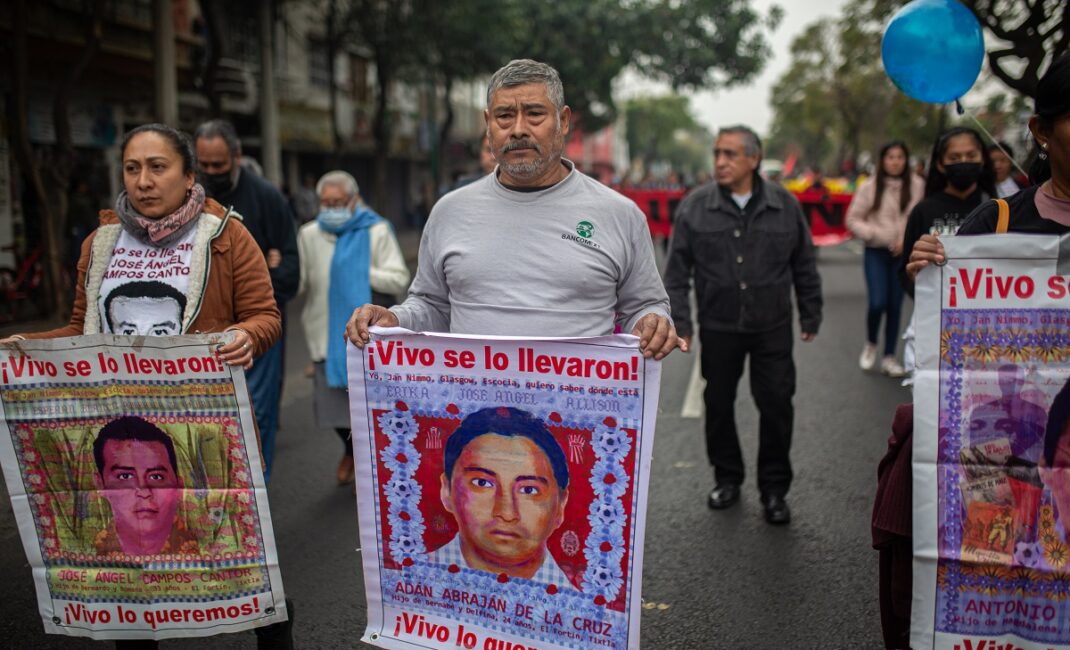
Parents hold images of their missing children at a protest against the forced disappearance of Los 43 de Ayotzinapa – by Paula González Gavilanes
The motive was exposed when at the request of the investigators, US authorities shared the ‘Chicago Wiretaps’, communications between members of the Guerreros Unidos cartel, which were intercepted by the American Drug Enforcement Agency (DEA) as part of an investigation into heroin and money trafficking between Mexico and the US.
Evidence suggests that every Friday, systematically, a bus carrying drugs would depart from Iguala to Chicago. It is likely that unknowingly, one of the buses the students took for the Tlatelolco protest, was loaded with drugs. As explained in the GIEI report, Ayotzinapa is a consequence of “the co-optation of the authorities by drug trafficking, and the protection of their interests”.
Despite important progress, the whereabouts of the remains of the students is still unknown. And in 2022, the relationship between the GIEI and the government of López Obrador broke down. The Group of Experts and the families of the disappeared students denounced the army’s refusal to release relevant information, such as the monitoring of the students they themselves had conducted.
Along with the Truth Commission, a Specialized Unit in the Attorney General’s office was created in June 2019 to investigate and bring the case to justice. Omar Gómez Trejo who knew the case and the families, from his previous work as Secretary General of the GIEI, was appointed head of the unit.
He says: “I was part of the unit up to September 2022. We set the base of the investigation in the four components of transitional justice. We needed to seek justice through compelling, strong evidence and penalize the participants of the disappearance and/or the cover-up.”
Despite arriving six years late to the investigation, Trejo says, he and his team were fortunate to find brave people whose testimonies provided key fragments of what had happened. The unit carried out an exhaustive and meticulous investigation, issuing more than 80 arrest warrants, including 20 against military personnel.
But the unit faced pressure from Obrador’s government. Trejo explains: “There was an urgency to close the Ayotzinapa case. Justice has its timeline and political decisions have theirs. When they coexist, the urgency of the political always prevails.” He adds: “I believe we got very close to those who really knew what happened, and that was the barrier to justice”.
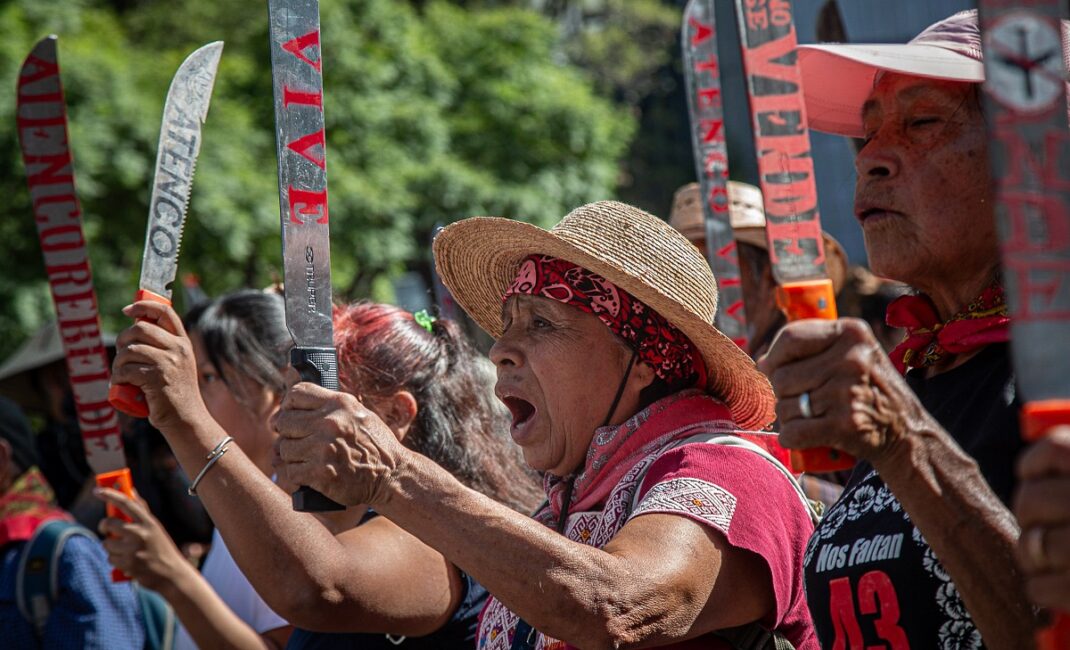
Women join the protest with political messages written on their blades – by Paula González Gavilanes
In September 2022, Trejo and key members of his team handed in their resignations.
The mechanisms implemented in the Ayotzinapa case, although promoted by president López Obrador, were the result of years of tireless struggle by the families and their representatives. Though inspired by transitional justice, they were hindered by political interests and a lack of independence from the state.
Trejo says great change is needed in Mexico, stressing that investigations must be transparent, placing the victims at the center, and prohibiting the intrusion of politics.

Crowds gather at dusk at the end of the protest against the forced disappearance of Los 43 in Mexico City – by Paula González Gavilanes
Since 2018, parents of the disappeared students have met regularly with the investigators, and with the outgoing president Lopez Obrador to discuss the case – a practice they expect to continue with incoming president Claudia Sheinbaum. They frequently organize political acts to, as Cristina puts it, “keep the fire of the case lit”. On the 26th day of every month, the parents travel 350km from Guerrero to Mexico City to hold a protest. “We never imagined we would reach ten years without having an answer of where our children are,” says Cristina.
Truth is the first step towards reparation
Little has been said on reparations in Ayotzinapa. When asked about this, Carlos Beristain, commissioner in the Colombian peace process and one of the five independent experts for the Ayotzinapa case, says: “The truth is the first step towards reparation. Finding the remains and knowing what happened is fundamental for the families.”
Beristain recalls that during Peña Nieto’s government, there were dubious attempts by authorities to offer money to the families as compensation. He recalls their response: “‘No. First the truth and then we’ll see’. This, in spite of the families’ enormous needs, because these are poor people who have endured a long fight in very difficult conditions.”
Beristain, who is also a physician with a PhD in psychology, adds that reparations must include health and psychological support, as well as assistance in labor or education, to mitigate the impact faced by families. He says high levels of stress lead to cardiovascular and endocrine diseases, altering the immune system and increasing the risk of autoimmune diseases and cancer. While there has been some attempt to give medical aid to the parents, Beristain says reparations have not been structured, despite the GIEI’s attempts and recommendations.
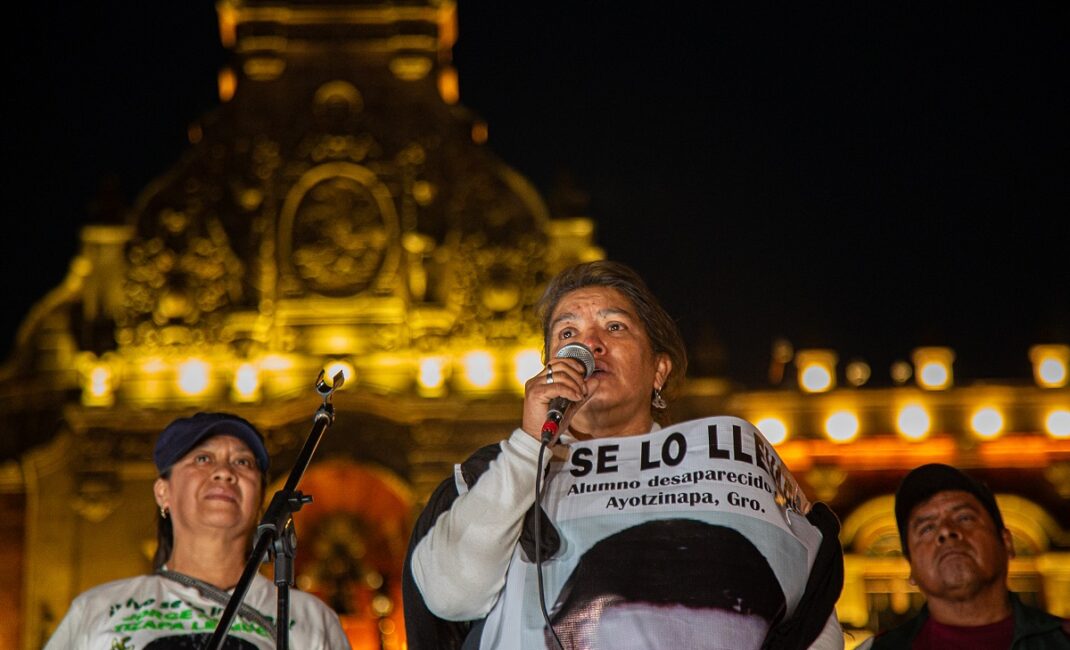
Parents and legal representatives take the stage at the end of the protest – Los 43 de Ayotzinapa by Paula González Gavilanes
I used to work in the fields,” says Cristina, “planting corn and beans. Baking bread and cakes was my other source of income.
After September 26, I left everything to go to Ayotzinapa, as the other parents did, when we found out about the forced disappearance of our children. It changed our entire lives. Most of us had to stop working, because now our job is to protest.”
She adds: “Not knowing where my son is, is terribly painful. I often wonder if they are harming him, forcing him to work, if he is eating, if he is hungry. Although time passes, you can’t forget your loved one, you cannot live in peace.”
Cristina, like many other parents, sometimes talks about her son as if he was alive and sometimes as if he was dead. Perhaps this reflects the emotional ambivalence created by forced disappearance. But perhaps it is also a political stance – a refusal to accept that their children are dead until they are presented with their remains or with irrefutable evidence that they were killed. The possibility of any of the students being found alive is extremely low, but the absence of truth and resolution restricts the families’ ability to grieve.
“¡Fue el Estado!”: Mexico’s crisis of forced disappearances
This suffering is shared by the families of more than 100,000 people who have gone missing in Mexico since Los 43. The nationwide movement for the disappeared is primarily driven by women, many of whom face threats and violence while searching for their loved ones, some of whom have even been murdered.
Last year alone in Mexico, a staggering average of 28 people went missing every day.
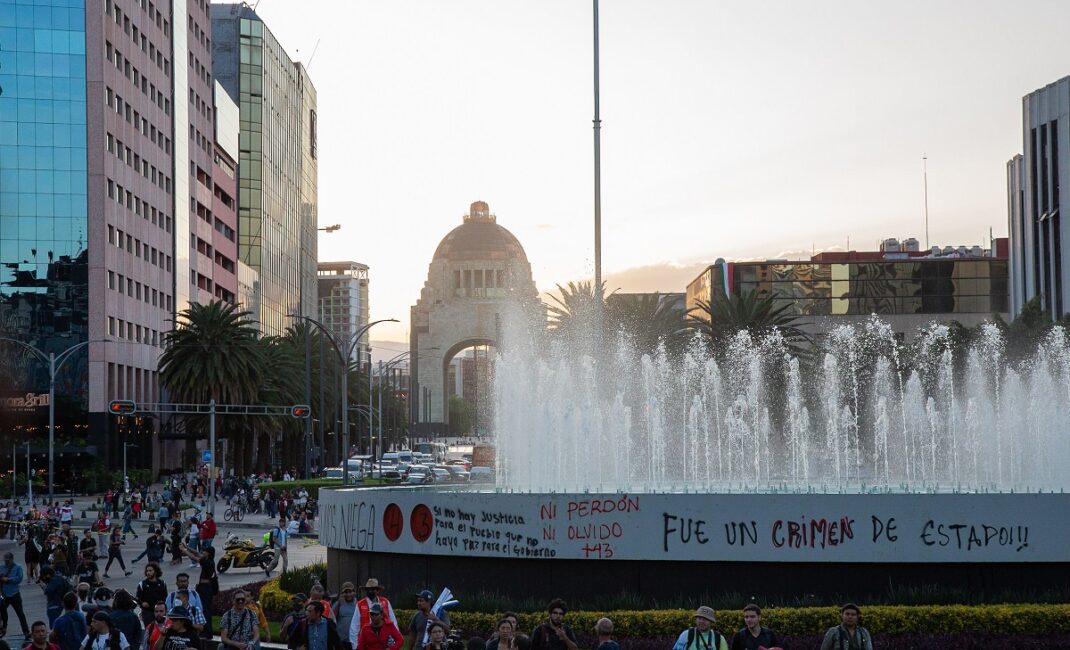
“Fue un crimen de estado!” [“It was a crime of the state”] – by Paula González Gavilanes
Aguayo emphasizes the importance of changing the narrative: “We need to demonstrate that it is possible to contain the violent actors. This requires, yes, force, but also knowledge, social participation and debate.”
The parents of the students continue their search for truth and justice. Cristina says: “I remain hopeful that someone will provide information so we can know about our children, and that the incoming president will continue the work. Our hope is that we will get to the truth and achieve justice for the students.”
On October 1 2024, Claudia Sheinbaum will take office as Mexico’s first woman president, inheriting the state’s historic debt to its citizens. Five days earlier, on the 10th anniversary of the disappearance of Los 43 de Ayotzinapa, the parents have called for a national protest. Cristina says: “Let the world know that we are here, demanding justice and the return of our children alive.”
All images by Paula González Gavilanes.
Read more:
- Mexico’s disappeared: Families seek truth, justice and memory in Michoacán
- Faltan 43: Can Human Rights Education Heal Mexico’s Deep Wounds?
- From Guayaquil to “Guaya Kill”? Examining Ecuador’s descent into drug violence
- Nepal’s civil war: “We are tired of promises, we need justice”
- Coffee, conversation and transitional justice in Sarajevo
